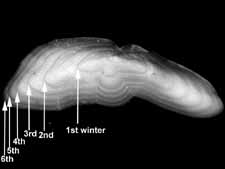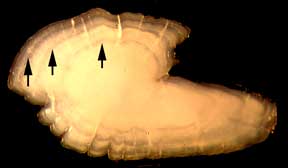Determining The Age of a Fish
Scales, bones, fin rays and otoliths have all been used to determine the age of fish, since these and other bony parts of fish often form yearly rings (annuli) like those of a tree. However, otoliths generally provide the most accurate ages, particularly in old fish.
The easiest way to "read" an otolith is to take a slice, or cross section, out of the otolith with a special saw and then count the rings under a microscope. However, unless you have access to a low-speed diamond-bladed saw in a laboratory, you won't be able to age the otolith this way.
If the otolith is thin enough, it may be possible to count the annuli without having to prepare the otolith first. Try measuring the thickness of the otolith. If it is 1 mm or less, or if the thickness is less than 1/8 that of the total length, you may be in luck. If you can see alternating light and dark zones, you're probably looking at annuli. They probably won't be as clear as those in a cross section, but they should look roughly similar.
If annuli aren't visible in the whole otolith, you'll have to crack the otolith in half, then lightly burn it, to make the annuli visible. To do this, you'll need a dissecting microscope, a piece of clay or plasticine, forceps or tweezers, an alcohol burner or candle, and some vegetable oil. To start with, you'll need to break the otolith along its centre (length-wise). The easiest way to do this is to place the otolith flat on the pad of your index finger, sulcus side up. The sulcus is the groove carved into the top of the otolith, and is usually found on the convex side (outward-facing curve). Take your thumb nail and place it over the otolith centre. Then press down firmly until the otolith snaps in half. Large otoliths can take A LOT of pressure before breaking. If you can't break it, try using pliers. But keep in mind that it's harder to control where the otolith breaks with pliers. And an otolith that's broken too far from the centre line cannot be aged.
An experienced otolith reader can age the cracked surface of the otolith with nothing more than a light coating of oil and the microscope. But you'll find it easier to read if you lightly burn the cracked surface first. The burning makes the annuli stand out as dark rings.
To burn the otolith, light the alcohol burner or candle and attach it firmly to a solid, non-flammable counter or bench. Grab one of the otolith halves with the forceps, holding it so that the cracked surface is oriented vertically, facing towards you. Then hold the otolith about 1 cm over the top of the flame, fairly near the cracked surface. In 5-15 seconds, the otolith should start to turn brown. Try to avoid getting soot on the cracked surface (eg- use a still, clean-burning flame). When the otolith is a medium brown colour, or if it starts to turn grey, remove it from the flame and put it on the counter to cool. BE CAREFUL - it will stay hot for at least a minute!
Once cool, take the otolith half and embed the non-cracked tip in the clay so that the cracked surface faces up. Spread a drop of vegetable or cedar oil over the whole cracked surface. Then put the clay holding the otolith under the microscope and focus at a magnification of about 10X. If a lot of soot is visible, try rubbing it off with an old cloth, or gently rub the cracked surface on a whetstone. Then add another drop of oil.
The annuli should be visible as thin but prominent brown or black lines. Keep in mind though that not every line is a yearly ring. So count only those rings or groups of rings which are most prominent. If no dark lines are visible, try re-burning the otolith. As a general rule of thumb, the annuli nearest the centre are furthest apart, and contain the most non-yearly lines. Later annuli (those nearest the edge), such as would be seen in an old fish, tend to be closer together and more regular in spacing. As a result, otoliths from older fish tend to be easier to age than those from younger fish!
Accurate age determinations of fish using otoliths requires A LOT of experience. And otolith annuli tend to be much less clear than those of a tree. So don't be discouraged if you don't end up with a clear-cut age, especially in a fish less than 3 years old. To find out about how many annuli to expect, try referring to a book which tells you how fast your fish species grows. But after ageing 10 or 20 otoliths, the patterns tend to become more clear, and you might be surprised how much more confidence you develop in your ages!


